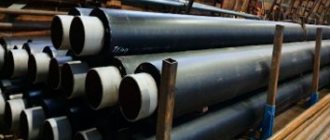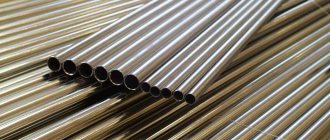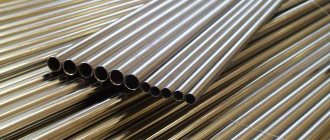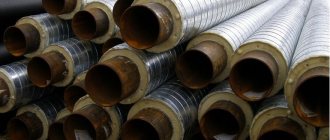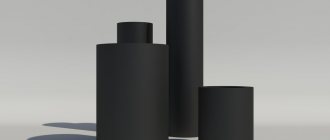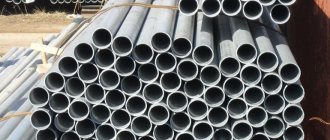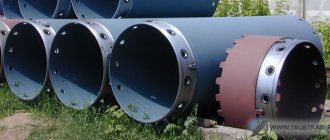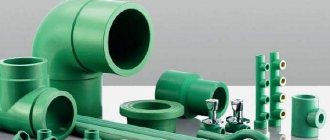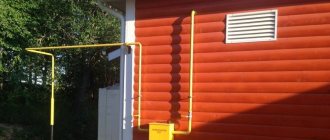Thermal insulation of polyurethane foam for pipes is an effective way to protect pipeline elements from freezing, used in various areas of construction, industry and production. The main material used is polyurethane foam, which is synthetic and consists of polyisocyanate and polyol. These components give it the structure of a hard foam.
If you need to order polyurethane foam insulation for a pipeline, study our company's catalog. We offer high-quality and safe building materials, which we purchase from trusted factories, at a competitive price and with a guarantee!
Thermal insulation of PPU pipelines: features and scope of application
On the market you can find various types of insulation based on polyurethane foam, which differ in structure, thermal insulation characteristics, possibilities of use and price, since they have different compositions and percentages of substances. Most often, polyurethane foam insulation is used in the following areas:
- Construction. The material is used to protect water and sewer pipes from the formation of condensation and ice, and to insulate the external parts of the pipeline, which are located on the outside of the building.
- Industry. For the operation of gas and oil pipelines, insulation is used, which protects the pipes from unnecessary heat loss, while being fireproof.
- Arrangement of communications for servicing technical facilities.
Most often, thermal insulation of polyurethane foam pipes is performed using a rigid type of polyurethane foam, which has low elasticity, good density and the largest number of closed cells. The material is produced in the form of finished products, which have half-shell-shaped elements and locks. The products are attached to the pipeline using clamps or wire; installation is possible regardless of the time of year. The upper part of such shells is made of foil; it additionally protects the structure from condensation and water.
Technology of pouring polyurethane foam composition
- Molds 1 m long are installed on the pipeline. Before filling, the mold is lubricated with an anti-adhesive lubricant (cyatim, litol, grease, etc.).
- Using a foam generator, the required amount of polyurethane foam composition is poured into a special hole in the mold.
- After pouring, the composition foams, expands and hardens, occupying the entire internal space of the mold. Several molds are filled at once.
- After 15–20 minutes, the forms are removed. In places where the molds are installed, foam plastic is formed - rigid polyurethane foam.
- The process of pouring the polyurethane foam composition into molds is repeated. After 15–20 minutes, the forms are removed.
- Thermal insulation of the pipeline section has been completed.
You can order thermal insulation coating for water supply and heating pipelines from our company. You can obtain all the necessary information from our managers in one of the ways convenient for you.
Advantages of polyurethane foam insulation
Thermal insulation of pipeline branches using polyurethane foam is a very good solution, since the material has many advantages:
- Long service life: it exceeds 30-35 years.
- Suppliers claim that the material does not change its qualities when exposed to temperatures from -180 to +130 degrees Celsius.
- Polyurethane foam is not susceptible to the negative effects of fungi or microbes, so it is not afraid of contact with moisture.
- The material is not destroyed under the influence of flammable substances, mineral oils, slightly alkaline solutions and light acids, as well as paints and varnishes.
- Manufacturers produce insulation in accordance with GOST-12.1.044, so the product does not deform under the influence of high temperature and does not burn when in contact with an open fire, but only melts at the edges.
Technical and operational characteristics of insulation
Production technology
Polyurethane foam is produced in hard and soft forms. The second type (also called foam rubber) has practically no strength, but is soft and flexible. That is why it is used only when creating things intended for everyday use, for example, furniture or clothing.
The rigid type of polyurethane foam perfectly repels water, and after hardening it firmly adheres to almost any surface. It can be metal, glass, wood, concrete, brick, etc. When applying liquid polyurethane foam there is no need for formwork or other additional fasteners.
Thermal insulation material can take absolutely any shape, and is also capable of completely filling the internal volume of a complex product. Therefore, polyurethane foam is often used in hard-to-reach places. The insulation creates a continuous and warm layer without joints. It is also capable of dampening vibrations.
An excellent quality is that PU foam can be used at temperatures from -200 °C to +200 °C. Solid polyurethane foam is an excellent waterproofing material. And also it does not react with most aggressive substances. The material is considered to be highly flammable and self-extinguishing.
A serious drawback can be considered intolerance to ultraviolet radiation. The polyurethane foam should not be exposed to direct sunlight.
Where is the best place to order material?
If you need to purchase insulation in Moscow, explore our range! We offer products from the best manufacturers, we provide a guarantee on all types of PU foam products, and we can deliver purchases throughout the city and region. Our company sets affordable prices, so it is very profitable to cooperate with us.
Underground laying of pipes protects them from freezing only if the depth of their laying exceeds the depth of soil freezing.
However, it is not always possible to fulfill this condition. Therefore, it is necessary to protect the pipeline from low temperatures using thermal insulation.
Insulation for water supply and sewer pipes in the ground is forced to work under special conditions, so it must meet a number of specific requirements.
PRICE LIST for thermal insulation services
| The cost of insulation with polyurethane foam (PPU) depending on the area with a thickness of 50 mm. | ||||
| Type of work | The cost of insulation when ordering an area | |||
| Up to 200 m2 | 200-400 m2 | 400 -1000 m2 | >1000m2 | |
| Spraying polyurethane foam with an average density of 30 kg/m3 | 700r/m2 | 650r/m2 | 600r/m2 | Negotiable |
| Spraying polyurethane foam with an average density of 40 kg/m3 | 800r/m2 | 750r/m2 | 650r/m2 | Negotiable |
| Spraying polyurethane foam with an average density of 45 kg/m3 | 1000r/m2 | 920r/m2 | 870r/m2 | Negotiable |
| Special conditions for construction companies and architectural bureaus! | ||||
| The cost of insulation with polyurethane foam (PPU) depending on the volume in m3. | ||||
| Type of work | The cost of insulation when ordering an area | |||
| Up to 5 m3 | 5-10 m3 | 10-20 m3 | >20 m3 | |
| Spraying polyurethane foam with an average density of 8-12 kg/m3 | 6000r/m3 | 5500r/m3 | 5000r/m3 | Negotiable |
| Spraying polyurethane foam with an average density of 25 kg/m3 | 11000r/m3 | 10500r/m3 | 9500r/m3 | Negotiable |
| Spraying polyurethane foam with an average density of 35 kg/m3 | 14000r/m3 | 13500r/m3 | 13000r/m3 | Negotiable |
| Spraying polyurethane foam with an average density of 45 kg/m3 | 18000r/m3 | 17500r/m3 | 16000r/m3 | Negotiable |
| Special conditions for construction companies and architectural bureaus! | ||||
The price may change depending on the difficulty of accessing the surface.
Minimum order 30,000 rubles.
offers professional assistance in insulating main, technological and utility network pipelines in Moscow and the Moscow region. For thermal insulation of engineering systems, the company uses effective systems based on polyurethane foam.
How to insulate pipes in the ground?
Thermal insulation materials used for insulation of underground pipes must have the following properties:
- moisture resistance: if the material is prone to water absorption, its protective abilities will be reduced to zero;
- high level of durability;
- Ease of use;
- low thermal conductivity;
- good tolerance to aggressive influences - biological and chemical in nature;
- good tolerance to mechanical stress;
- neutral reaction to temperature fluctuations.
Fibrous materials and polymers are used as insulation materials for use in the ground. The first include mineral wool - glass, basalt, etc. Among the polymer materials most used in these conditions are polyurethane foam and extruded polystyrene foam.
Blockages in the kitchen are a common occurrence and many housewives prefer to use folk remedies for cleaning pipes. Does baking soda and vinegar help in cleaning pipes? Read on.
Why water pipes are humming and how to find out the cause of the problem, read here.
If you want to quickly build a drainage hole, then the easiest and cheapest option is to make it from tires. In this topic https://aquacomm.ru/cancliz/zagorodnyie-doma/avtonomnaya/stoki/vyigrebnaya-yama-stoki/slivnaya-yama-iz-pokryshek.html we will analyze the simplest option for constructing an autonomous sewage system from old tires.
Mineral wool
In private construction, mineral wool is most often used to insulate underground pipelines.
It’s easy to work with – just cover the pipes with this material and secure it with tape.
The degree of protection of pipes with mineral wool is quite high, and it is inexpensive.
Mineral wool is not susceptible to rotting, which is undoubtedly a big plus for insulation used in the ground.
One of the types of mineral insulation intended for insulating pipelines laid in the ground is basalt shell. Structurally, it is similar to polyurethane foam shells. The surface of the semi-cylinders has a protective coating - made of aluminum foil, fiberglass, fiberglass, etc.
During installation, the basalt shells are covered with metallized foil. Transverse joints between individual insulation elements are similarly protected.
Extruded polystyrene foam
Extruded polystyrene foam, unlike regular polystyrene foam, is a high-density foam mass with closed cells.
This structure allows the use of this material in wet soils.
Shells made from extruded polystyrene foam consist of separate segments. Their number depends on the diameter of the pipe being insulated. To connect individual parts of the shell, a tongue-and-groove lock is used.
Expanded polystyrene has sufficient strength that allows it to be used for channelless underground installation.
To secure the mounted segments, polymer or metal tapes, wire or mounting tape are used.
Pros and cons of different materials
Any of the above thermal insulation materials has quite a number of positive qualities.
They also have some negative traits.
Therefore, many private developers, without further ado, choose insulation based on its very tangible feature - price.
And in vain: it would be necessary to conduct a basic analysis of the properties of thermal insulation materials in order to understand - have you actually saved? After all, such important parameters as thermal conductivity, durability,
Table 1 shows the comparative characteristics of the most commonly used insulation materials.
| Material | Density, kg/cubic. m | Thermal conductivity |
It remains to compare the durability of these materials:
- mineral wool will last from 10 to 20 years;
- polyurethane foam has a higher durability - from 30 to 50 years;
- extruded polystyrene foam does not lag behind polyurethane foam: its service life, according to manufacturers, is 50 years.
Based on the above, it is fair to note that choosing insulation only based on its cost is a fundamentally wrong decision. You can buy cheap mineral wool, but after a dozen or two years you will have to pay a certain amount again - and it is far from certain that the price of the material will be the same. Add to this amount the cost of dismantling and installation (including excavation work) - perhaps a detailed calculation will convince you to buy a not cheap, but more durable polyurethane foam.
But first, let's see whether the prices for mineral wool, polyurethane foam and extruded polystyrene foam are much different.
Laying and joining
The process technology is quite simple. Installation takes just a few steps. Algorithm for performing the work:
- The products are cleaned on both sides of the heat-insulating layer by approximately 30 cm.
- Welding is in progress. Seam quality control is carried out with a special device called a flaw detector.
- A heat shrink sleeve is installed on the connection.
- The empty space under the coupling is filled with foam, and then the coupling is heated to shrink it while simultaneously controlling the tightness.
It must be remembered that polymer materials do not tolerate high temperatures. The end parts of the insulation are protected by non-flammable screens during pipe welding. This could be, for example, asbestos fabric.
The process of laying networks from polyurethane foam pipes does not take much time. This cannot be said about thermal insulation using glass wool. Its fastening and subsequent plastering require a lot of painstaking work.
Sometimes installation of such structures in the ground is carried out without digging trenches. Many enterprises use horizontal drilling during installation.
In densely populated areas there is always heavy traffic, so digging up the road usually causes big problems. The best solution in such a situation would be to lay networks using horizontal drilling.
Price
Let’s take 1 cubic meter of insulation per unit of production.
So, cube. m will cost:
- mineral wool – from 30 to 50 euros;
- polyurethane foam – 220-350 euros;
- extruded polystyrene foam – 75-90 euros.
Despite the difference in prices from different manufacturers, their approximate ratio remains the same.
The figures presented in this and the previous sections allow us to conclude that the most profitable material for private construction is extruded polystyrene foam: it costs approximately twice as much as mineral wool, and can last several times longer.
Metal-plastic pipes are flexible and have anti-corrosion properties. You can find out more about them in the article: metal-plastic pipes - application and technical characteristics.
Read about how to build a water supply system in a dacha from a well on this page. Useful recommendations for installation work.
Why insulate pipelines
Thermal insulation of pipelines is a functional part of the operation of heating mains, through which heat is supplied to houses, factories and buildings in the form of water, steam, gas, and oil. If pipes are not insulated, energy loss can be up to 35%. In addition, metal is susceptible to corrosion, fungus, mold, and aggressive environments. Thermal insulation of heating pipelines with polyurethane foam is necessary: polyurethane foam retains heat well due to its low thermal conductivity coefficient, does not allow water to pass through, and is sprayed in a single continuous layer. Airless high and low pressure installations allow you to spray PU foam over an area of 500 m2 within one day.
Previously, heating mains were insulated with mineral wool and expanded polystyrene (you can read more about the technologies in the article). But mineral wool absorbs moisture, which subsequently reduces the ability to retain heat. Expanded polystyrene is susceptible to combustion, emits a pungent toxic odor, and is inconvenient for installation.
Video on the topic
Among all materials for thermal insulation, foamed plastics (foams) are the most popular in everyday life and in industry. One of their varieties is polyurethane types, used in industry and utilities as polyurethane foam insulation for pipes.
The use of ready-made factory pipes with thermal insulation allows you to save time and money when installing pipelines and significantly reduce heat losses during the operation of heating and plumbing systems, saving significant money. When laying pipelines from insulated pipes, welding and special laying technology are used using insulating segments at the joints and turns of the pipeline.
Fig.1 Appearance of products with PPU insulation
Scope of application
Pipes in a shell made of polyurethane foam have a high degree of reliability and a long service life.
Pipes in a shell made of polyurethane foam have a high degree of reliability and a long service life. Thanks to this, they are used both in everyday life and in the creation of engineering networks to provide the population with hot water. They have even found their place in the oil industry.
Nowadays, when installing water supply systems in houses, both steel and polyethylene pipes with a polyurethane foam shell are used. The price of the product is quite high, but it is fully justified by the ease of installation and quality characteristics.
If we note the industrial scale, then the use of networks with polyurethane foam insulation significantly increases efficiency. That is why during reconstruction heating mains are made from such pipes.
The products are also gaining popularity in the oil industry. Polyurethane helps slow down corrosion.
What are PPU pipes?
Standard pipes with polyurethane foam (PUF) insulation have a two-layer coating consisting of a foam insulator with an air content of about 98% and an outer durable polyethylene (HDPE) shell as protection. Sometimes the production technology provides for a three-layer coating of two HDPE shells, between which a polyurethane foam insulator is located.
The industry produces insulated pipes placed in a different type of outer shell - galvanized insulating steel, which allows for higher coating strength. Some galvanized and polyethylene shells are additionally equipped with stiffeners, which further increase their strength. In the marking for shells, an additional designation is introduced - PE for polyethylene and OC for galvanization.
Main advantages
A huge percentage of apartment buildings in the country are connected to centralized heating and hot water. After heating, the liquid reaches the end consumer through pipes. At this stage, it is very important to ensure the minimum possible heat loss.
For quite a long time, ordinary glass wool was used for thermal insulation. The insulation was carried out as follows:
- the pipe was wrapped with an insulator;
- fastening was carried out using steel wire;
- then the pipe was covered with galvanized sheets.
In the 90s of the last century, metal theft reached its peak, so galvanized steel was gradually stopped being used. The surface of the pipe was often simply coated with sand-cement mortar. Of course, no one stole such material, but this solution significantly increased heat losses.
Relatively recently, new designs have appeared on the market - pipes insulated with polyurethane foam. And at the same time, they began to produce separately polyurethane foam shells, which were intended for insulating already laid pipes.
This material (when compared with the previous type of insulation) has many positive qualities. Among them are the following:
- Easy installation.
- These products can be laid in the ground without an additional protective box.
- The pipeline always has the same heat loss rates at absolutely any humidity. Glass wool, after getting wet in the rain, loses its quality to a significant extent.
- Pipe corrosion is greatly reduced.
The most important positive quality of polyurethane pipe insulation is the saving of most of the thermal energy. In old methods of insulation, the tolerance reached up to 20%, but for PPU insulation it is only 3%. Although in this case there is room for improvement, because on a city scale 3% translates into a large amount.
Pipes in polyurethane foam - areas of use and technical characteristics
GOST 30732-2006 regulates the technical conditions for pipes with polyurethane foam insulation and specifies their scope of application in the following conditions:
- Pipes in a PE shell are designed for underground installation of heating networks using a ductless method (lowering into earthen trenches).
- Pipes in a protective metal sheath are designed for installation in passageways, tunnels and on the ground surface.
- The operating pressure in the system should not exceed 16 bar.
- Media temperature – up to +140º C, or +150º C when used in highways with its values ranging from +70 to +150 C.
It is allowed to use pipelines for water supply and sewerage, oil and gas supply, in industrial engineering networks when moving liquids from tanks, large containers and storage facilities.
Rice. 3 Polyurethane foam pipe insulation - parameters
Dimensions of PPU PE: internal and nominal diameters
| Steel pipe dimensions | Type 1 (standard) | Type 2 (reinforced) | |||
| Outer diameter | Minimum wall thickness | Diameter of the PE shell (the minimum wall thickness is indicated in parentheses) | Polyurethane foam, layer thickness | Diameter of the PE shell (the minimum wall thickness is indicated in parentheses) | Polyurethane foam, layer thickness |
| 32 | 3 | 90 (2,2); 110 (2,5);125 (2,5) | 26; 36,5; 43,5 | — | — |
| 38 | 110 (2,5); 125 (2,5) | 33; 40,5 | — | — | |
| 45 | 125 (2,5) | 37 | — | — | |
| 57 | 125 (2,5) | 31,5 | 140 (3) | 38,5 | |
| 76 | 140 (3) | 29 | 160 (3) | 39 | |
| 89 | 4 | 160 (3) | 32,5 | 180 (3) | 42,5 |
| 108 | 180 (3) | 33 | 200 (3,2) | 43 | |
| 133 | 225 (3,5) | 42,5 | 250 (3,9) | 54,5 | |
| 159 | 4,5 | 250 (3,9) | 41,5 | 280 (4,4) | 55,5 |
| 219 | 6 | 315 (4,9) | 42 | 355 (5,6) | 62 |
| 273 | 7 | 400 (5,6) | 57 | 450 (5,6) | 81,5 |
| 325 | 450 (5,6) | 55,5 | 500 (6,2) | 79,5 | |
| 426 | 560 (7) | 58,2 | 630 (7,9) | 77,6; 92,5 | |
| 530 | 710 (8,9) | 78,9 | — | — | |
| 630 | 8 | 800 (10) | 72,5 | — | — |
| 720 | 900 (11,2) | 76 | — | — | |
| 820 | 9 | 1000 (12,4) | 72,4 | 1100 (13,8) | 122,5 |
| 920 | 10 | 1100 (13,8) | 74,4 | 1200 (14,9) | 120,5 |
| 1020 | 11 | 1200 (14,9) | 70,4 | — | — |
| 1220 | 1425 (17,3) | 79 | — | — | |
| 1420 | 12 | 1600 (19,6) | 90 | — | — |
*The wall thickness of the steel pipe is for reference. Other parameters may be specified in the project.
The marking of PPU PE pipes must contain the product designation, the name/trademark of the manufacturer, the number and date of manufacture of the batch. Information is applied to the surface of the shell using a stencil or stamp; it is also possible to use tags.
PPU insulation for pipes - pros and cons
The high performance properties of pipes in polyurethane foam insulation are due to the production technology, which includes the following stages:
- The outer polyethylene shell is produced by extrusion. To do this, polyethylene is squeezed out of a special mold, which hardens to a solid state.
- A steel pipe is inserted into the outer HDPE shell on spacers and copper cables are placed.
- Molten polyurethane foam is fed into the space between the walls of the steel and plastic outer pipe, which, after hardening, forms the finished product.
Advantages of PPU thermal insulation
Polyurethane foam insulation on pipes and their use has the following advantages over other technologies:
- In everyday life, polyurethane foam rubber is widely used as insulation; foam material, its solid counterpart, belongs to the class of foam plastics - materials that have air cells in their structure.
- High-quality factory production of products allows pipelines to be lowered directly into the ground, under water, without additional devices.
- Among its analogues - polyvinyl chloride, phenol-formaldehyde, urea-formaldehyde and polystyrene foams, polyurethane foam has the lowest thermal conductivity (0.02 W/m*K) - almost two times less than that of polystyrene foam.
- When installing a pipeline with ready-made thermal insulation, the speed of work increases significantly; enterprises manufacture ready-made shaped products in thermal insulation (tees, bends, transitions, branches) to simplify installation.
Fig.4 Steel pipes with PPU insulation in a polyethylene sheath - dimensions
- The heat-insulating layer applied at the factory is sealed and of high quality; one of its important additional properties is to provide reliable protection against corrosion.
- The presence of built-in copper indicator conductors allows you to detect areas of thermal insulation with high humidity - this simplifies repair work in case of line damage.
- PPU pipelines are designed for long-term operation without maintenance for a minimum period of 30 years. To increase it, the galvanized shell is often coated with special protective compounds (varnishes, paints, polymers), which during operation perform anti-corrosion functions and can be renewed several times.
Fig.5 Pipes in polyurethane foam insulation in a galvanized OC shell - dimensions
Disadvantages of PPU insulation
The disadvantages of polyurethane foam insulation include the following factors:
- The material is flammable, excluding the effect of an open flame on the end sections of the insulator, its ignition temperature is 550 - 600 C., and highly toxic products are formed during combustion.
- PPU steel pipes are susceptible to corrosion and need to be replaced after a certain service life.
- Polyurethane foam is destroyed under the influence of ultraviolet radiation at a speed of 0.05 mm. in year.
- Weak mechanical strength, which is compensated by the outer shell.
- If moisture is detected in the insulation layer, the damaged area cannot be repaired and needs to be completely replaced.
Rice. 6 Polyethylene sheath for PPU pipes - characteristics
PPU spraying technology for pipeline thermal insulation
Before spraying, heat up the components: component A to +30 °C, component B to +40...+50 °C. Stir polyol component A for 10–15 minutes. Component B does not need to be mixed if the temperature at the place of its storage is not lower than +15 °C.
After preparing the surface using a low or high pressure unit, you need to set the thickness of the coating. It should be no more than 25 mm in one pass. The fewer layers of insulation, the higher the performance of the foam. If spraying is carried out on cold surfaces, the formation of the first layer takes longer.
To determine the optimal technology for thermal insulation of polyurethane foam pipelines, it is necessary to conduct a test spraying. To do this, treat a small area. After 10 minutes from the start of the reaction, check the sample for bubbles, breaks and craters.
During operation, monitor the pressure level in the hoses, the serviceability of the thermostats, and the cleanliness of the filters. The hoses must be straight and without kinks.
It is better to spray polyurethane foam from a distance of one meter from the surface. The spray nozzle must be perpendicular to the surface. Work without jerks or breaks. In one pass you can process 10 meters of surface. 5–30 minutes after applying the first layer, begin spraying the next one.
When insulating heating mains, products made from polyurethane foam - shells - are also used. The material is poured into a mold to create cylinders of polyurethane foam, which are then placed on the pipes. They are secured with metal bands and polyurethane glue.
Watch the video of the production process of polyurethane foam shells.
The disadvantage of this method is the time required. To make shells, you need to organize an entire production. You can read more about this here.
PPU insulation for shell pipes
In addition to factory-made steel pipes insulated with polyurethane, the construction market offers a wide range of shell insulation, mounted on pipelines of suitable diameters made of various materials and widely used in everyday life.
PPU shell insulation has the following parameters:
- The operating temperature range of the material used is from -190 to +150 C.
- The material is water-repellent, does not absorb moisture, its water absorption is less than 2%.
- The shell is light weight and is simply mounted by joining two segments into grooves; if necessary, the damaged area can be easily replaced, and the entire insulation can be reused after dismantling.
- The material is not susceptible to biological effects (mold, mildew), does not rot, and its service life is about 30 years.
- Polyurethane foam is inert to most chemicals and resistant to their effects.
- The shell is strong, hard varieties have a density of 40 to 60 kg. /m. cube
- The outer shell can be made of paper, fiberglass, foil, galvanized steel and other materials.
Rice. 7 Pipe in shell insulation
Configuration
Polyurethane foam shells are produced not only at industrial enterprises, but also in a semi-handicraft way at a number of small private industries thanks to simple technology. During manufacturing, a two-component composition is poured into the mold, the parts of which are Polyisocyanate and Izolan, and after hardening, the finished product is obtained.
The standard form of the products is a shell of two component cylindrical parts 1 meter long, which is mounted with a conventional connection and fixed using adhesives, adhesive tapes, polyurethane foam, clamps and ties. For large pipe diameters, the number of segments in the shells can reach up to four.
Requirements for sprayed surfaces
Before starting work on spraying thermal insulation from polyurethane foam onto the pipeline, the surface must be prepared. This will affect the quality of the sprayed layer and help increase adhesion to the surface. The surface must meet the requirements of SNiP 3.04 01-87. In winter, polyurethane foam can also be sprayed, but it is necessary to use spray systems marked “Winter”. For example, SKN-30/141-G3 (winter), SKN-40/141-G3 (winter), SKN-60/141-G3 (winter).
Polyurethane foam can be applied to roofing felt, slate, metal without dismantling them, but after preparing the surface for spraying:
- Clean the pipeline from dust, dirt, and oils.
- Remove corroded areas.
- Check the surface for uniformity; there should be no peeling or broken parts.
- Ensure the air and surface temperature in the work area is at least +10 °C when working with summer systems and -10 °C when working with winter spraying systems.
- Check surface moisture. It should be dry.
PPU shell coating
In the production of insulation shells, various methods are used to protect and strengthen its outer shell from physical and natural influences - this expands the scope of use of the material for domestic and industrial needs.
Without cladding
Sheath without lining is a budget option and is used for laying pipelines indoors without access to sunlight; sometimes it is wrapped with light-protective material or painted with thick, opaque paint.
Lining made of kraft paper or glassine
This cladding option is convenient because it allows you to save money on painting or protecting the shell from ultraviolet radiation in the uncladding version; the shell has an aesthetic appearance and does not require further processing. Mainly used in conditions where there are no mechanical loads on the surface - on highways inside industrial premises.
Fig.8 Heat-insulating shell coated with fiberglass, foil, galvanized, glassine
Fiberglass cladding
Products in a fiberglass shell are mainly used on external and underground pipelines - fiberglass is sufficiently resistant to large depths and mechanical loads. The fiberglass used reliably protects the product from ultraviolet radiation and chemical influences of the environment.
Galvanized or foil-coated products
Galvanized coating is used to protect pipelines laid by air on the street and underground, providing reliable protection not only from ultraviolet radiation, but also from vandals.
Several types of foil materials are used to cover the shell shell.
Foil pergamine (aluminum foil with a rubber-bitumen base) has high strength characteristics and additionally reflects thermal energy. Reinforced aluminum foil on a fiberglass mesh - Armofol also reflects thermal energy and is designed for use in pipelines with significant temperature differences.
Rice. 9 Dimensions of polyurethane foam shells
Advantages of polyurethane coatings
Polyurethane has a number of properties that provide reliable protection of pipelines from corrosion and mechanical damage, including
- high mechanical strength;
- excellent adhesion to metal;
- low thermal conductivity;
- low hygroscopicity.
The polyurethane coating prevents metal from coming into contact with moisture. This material is reliable and durable, allowing you to increase the service life of the pipeline to 50 years or more. Affordable prices for polyurethane insulation ensure the demand for the presented technology.
PPU shell dimensions
The dimensional parameters of polyurethane shells must be combined with the diameter of the pipelines for which they are intended to insulate; in some cases, multilayer insulation is also produced - this requires matching the outer and inner diameters of shells of various sizes.
PPU shell internal diameter
The construction market offers products with an internal diameter from 57 to 1420 mm. (TU 5768-001-86901126-2011) from leading large Russian manufacturers with large production areas. Many handicraft enterprises produce their products with the most popular internal diameter sizes from 40 to 400 mm, satisfying the needs of most small consumers.
PPU shell thickness
The characteristics and dimensions of the shells are closely related to the dimensional parameters of the pipeline on which they are mounted - the larger the diameter, the higher the other dimensional parameters, usually the thickness varies from 20 to 100 mm.
Angle of contact of half-segments
The standard length of shells is 1 meter; with different diameters of pipelines, to facilitate installation and production, it is made from a different number of segments, the usual number of which does not exceed 4.
The corresponding contact angle for segments (radial angle) according to TU 5768-001-86901126-2011 is:
- 180 degrees for two elements, applies if the pipeline diameter does not exceed 530 mm.
- 120 degrees for 3 segments with external pipeline dimensions from 530 to 820 mm.
- 90 degrees with line diameters from 820 to 1420 mm.
Rice. 10 Pipes insulated with polyurethane foam and shells - marking
General information about PPU thermal insulation
Pipes insulated with polyurethane foam (PE) are now very widespread in the installation of various utility infrastructure networks. They are used for both underground and above-ground route laying methods. In rare cases, a polyethylene pipe with polyurethane foam insulation is used, where plastic is used instead of steel.
The upper protective shell can also be made from galvanized sheets. It all depends on future operating conditions:
- Polyethylene (PE) is used for underground installation. This material is a polymer that copes well with temperature changes, resists various chemical influences, and also has high strength characteristics.
- For above-ground installation, galvanization is used. Production involves applying a layer of protection to sheet metal, which during oxidation forms a film that resists corrosion.
Polyethylene perfectly protects the product from moisture, so it is always used for underground installation. For above-ground installation, a more reliable solution would be to use galvanization.
Marking of industrial pipes with polyurethane insulation and shells
The designation of industrially produced products according to GOST 30732-2006 includes the symbols:
- The abbreviated name of the pipe material, usually steel with the designation St.
- Outer diameter (mm).
- Wall thickness (mm).
- For products with HDPE casing, insulation class (1 - normal, 2 - reinforced).
- The designation of the heat-insulating material is polyurethane foam.
- Marking of external protection (PE - polyethylene, OTs - galvanized steel)
- Reinforcement with bandages – B.
- Indication of the corresponding GOST 30732-2006.
The shell designation consists of the following symbols:
- Product name, shell – SK.
- Inner diameter (mm).
- Manufacturing material (PPU polyurethane foam).
- Thickness of the heat-insulating layer (mm.).
- Availability of a protective outer coating (PO).
Rice. 11 Examples of shell and pipe installation
Application of polyurethane coating at a competitive price
The first stage of work is sandblasting the metal surface. Next, polyurethane is sprayed using specialized high-pressure equipment from GRACO (USA). Coating sequence:
- a film with a thickness of 0.7-0.9 mm is applied;
- coating thickness is increased to 2.5 mm (according to GOST 51164-98, GOST 9.602-2005);
- The thickness of the coating, its adhesion and other parameters are checked.
To assess the quality of a polyurethane coating, a high-voltage flaw detector is used to detect cracks, unpainted areas and other coating defects. The thickness of the coating, its dielectric continuity, and the geometry of the edge bevel are also assessed. As a result, we receive a pipe or fitting that is reliably protected from corrosion.
Work on installation of polyurethane foam shell
Laying pipes in a polyurethane foam shell with your own hands is not particularly difficult and is accessible to almost anyone - the segments are light in weight and 1 meter long.
For domestic use, shells and pipes of small diameter can be laid on the ground and lowered into a trench after connection; in the case of heavy main pipelines, installation is carried out directly in trenches or on the surface when located externally. A step-by-step method to insulate a pipeline with your own hands consists of several simple operations:
- A segment is placed on a section of the pipeline and connected to other parts using locks with a slight shift of 1/3 of the length.
- To secure the fragments, glue, adhesive tape, ties and clamps are used.
- Curvilinear sections of pipelines are insulated with segments that are cut from the shell or purchased together with the main components; they are also secured in offset grooves and secured with additional fasteners.
The production of pipes in polyurethane foam is the main method of insulating heat-conducting mains in the industrial and public sector due to the unique properties of the material - increased thermal protection of all insulators. In the domestic sphere, insulated polyurethane foam shells are used in the form of a shell - they are used in heating systems, hot and cold water supply and sewage systems (for protection against freezing).
| Mineral wool | 20-80 | 0,038-0,047 | 0,3-0,37 |
| Extruded polystyrene foam | 25-40 | 0,035-0,05 | 0,005-0,013 |
| Polyurethane foam | 27-35 | 0,03-0,035 | 0,05 |
Plastic flexible pipes PPU
The insulated plastic flexible structure is made entirely of polymer components, combining the best performance qualities. It is used in the construction of heating networks, hot and cold water mains, technical systems for the food and chemical industries. Flexible pipes have the characteristics of polyurethane foam plastic pipes; their peculiarity is simplified laying and installation due to their length (up to 400 m in a coil). The pipeline requires fewer connecting and rotating parts; it is possible to form a pipeline line of any complexity without expansion joints or supports, even in seismically hazardous areas. Possible bending radius is 800-1200 mm. Laying underground in a channel and without a channel.
Insulated flexible pipes are also made from polymers
The main pipe is made of cross-linked polyethylene, the basis of which is high-density polyethylene (HDPE). Its molecular structure is cross-linked from the effects of peroxides (PE-Xa) or silanides (PE-Xb) at the time of extrusion, and a three-dimensional plastic structure with unique properties is formed: high strength, heat resistance, elasticity, molecular (temperature) memory (restoration of the original state after deformation and heating). There can be from 1 to 4 such products in one polyurethane foam insulation. Diameter from 16 mm to 110 mm, operating pressure 6, 10 bar.
It is also possible to cover the system with layers of reinforcing fiber and a polymer shell to protect the system from oxygen. The anti-oxygen barrier (hydroxide-ethyl vinyl layer) prevents the penetration of oxygen vapor through the walls of the plastic into the heating system, reducing corrosion and extending the service life of the pipes.
Thanks to the combination of components, the polyurethane foam shell acquires elastic properties, reducing the stiffness index. Semi-rigid PPU insulation gives flexibility to the pipes without losing their heat efficiency. Reliable adhesion to the PE surface prevents delamination during thermal elongation. Winding tubular products with a coil or drum does not violate their solidity and integrity. The thickness of the polyurethane foam layer can be determined by the customer based on the project or installation environment conditions (regular, reinforced). The outer waterproof polyethylene layer is produced in the form of corrugation. The flexible design is complemented by a heating cable. The diameter of the jacketed pipe is from 90 mm to 160 mm.

